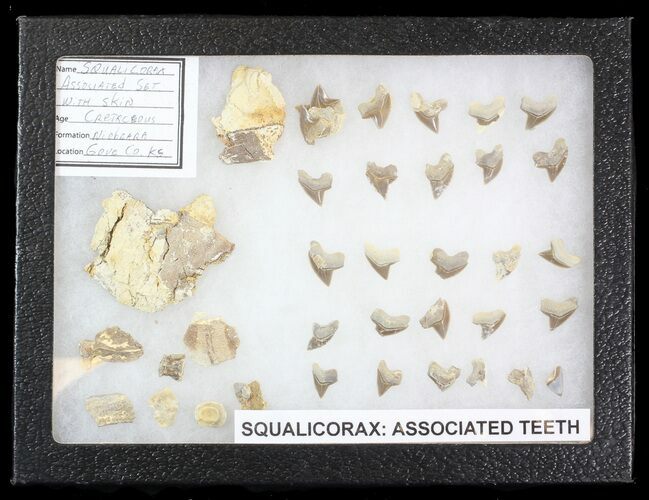This Specimen has been sold.
27 Associated Squalicorax Teeth With Fossil Skin - Kansas
This is a set of 27 Squalicorax teeth from the Smoky Hill Chalk of Kansas found in association from a single shark. There are also several sections of preserved skin (dermal denticles) from the head of the shark. While isolated teeth are common, finding teeth in association, particularly with other preserved parts of a shark are quite rare. The set comes in a riker mount display case.
Squalicorax also referred to as a "crow shark" is an extinct lamniform shark that lived during the Cretaceous. It was medium size, typically about 2 meters in length and would have a body similar to most of todays modern grey sharks.
During the Late Cretaceous, much of the middle of the United States was covered by the Western Interior Seaway effectively splitting the continent in two. The Niobrara Formation in Kansas is one of the best known localities for marine fossils deposited during this time. These fossils include the remains of giant marine predators including Mosasaurs, Plesiosaurs, sharks like Cretoxyrhina and the giant predatory fish Xiphactinus.
Squalicorax also referred to as a "crow shark" is an extinct lamniform shark that lived during the Cretaceous. It was medium size, typically about 2 meters in length and would have a body similar to most of todays modern grey sharks.
During the Late Cretaceous, much of the middle of the United States was covered by the Western Interior Seaway effectively splitting the continent in two. The Niobrara Formation in Kansas is one of the best known localities for marine fossils deposited during this time. These fossils include the remains of giant marine predators including Mosasaurs, Plesiosaurs, sharks like Cretoxyrhina and the giant predatory fish Xiphactinus.
SPECIES
Squalicorax
LOCATION
Gove County, Kansas
FORMATION
Niobrara Formation, Smoky Hill Chalk
SIZE
Largest Tooth .62" long
CATEGORY
SUB CATEGORY
ITEM
#42976
We guarantee the authenticity of all of our specimens.
 Reviews
Reviews















